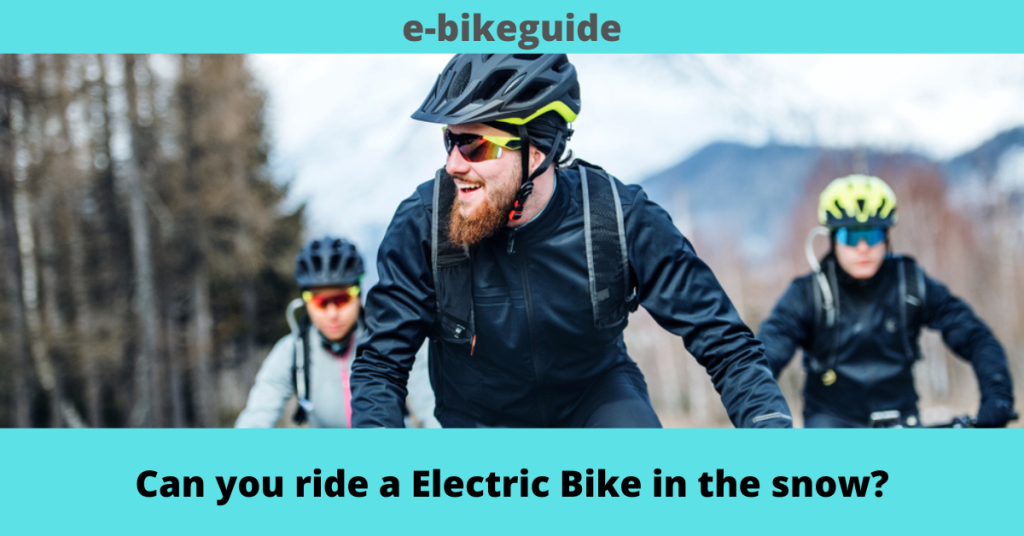Do you allow Electric Bikes to operate in snow?

For a variety of reasons, winter continues to be a concern for the majority of e-bike riders.
In reality, ignoring the snowier months would be disastrous for an owner of an e-bike and just would not do. Even electric bikes built for colder locations shouldn’t be taken for granted when it comes to their complete resistance to icy (and filthy) factors. It is imperative to exercise extra caution because winter weather can be quite unexpected. Have you recently purchased an e-bike for the holidays? Or perhaps you’ve been riding all year but are suddenly confronted with the icy realities of winter e-biking? To make the most of your e-bike and your winter riding experience, check out these suggestions from several e-bike manufacturers.
Cold and Moisture are the two most obvious factors to keep in mind when riding your e-bike in the winter. Both of these situations could be harmful to your bike and its electrical system, but many of the e-bikes available today are actually built to withstand them. For instance, fat bikes, which have become the plus-sized SUVs of the e-bike market in recent years, were first created expressly for riding in the winter. The larger contact patch and wider tires give the vehicle excellent grip in slick weather and outstanding flotation in snow. Many e-bikes are even made to withstand water, protecting the more delicate electrical components from the damp, freezing, and other conditions that are so common throughout the winter in many parts of the country. These best practices will help people who refuse to let Old Man Winter ruin their e-bike trips. So, now if you’re asking me that “can I ride my e-bike during winter or snow?” You can ride your e-bike in the cold, without a doubt. even though there is a lot of snow on the ground and the weather is wetter and slicker than typical. All you have to do is be willing to spend the time getting your e-bike and yourself ready for those weather conditions. First, read these tips before hitting the snow!
-
Winterize your bike
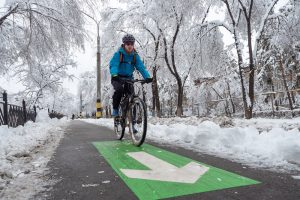
Numerous other considerations should be kept in mind in addition to the battery’s obvious importance in order to keep your e-bike from developing the aforementioned common problems.
Once you master them and devote time to practicing them each winter, you will always be one step ahead of those issues.
The issue with road muck in the winter is that it frequently contains salt and other corrosive compounds, in addition to having an abrasive effect on your bike’s transmission (chain, derailleur). Even if you have to clean your bike after every ride, it shouldn’t take more than five minutes if you have access to an outdoor tap and hose. If ignored, this can build up and substantially shorten the performance and lifespan of your components. It is worthwhile to get a product like Muc Off bike protect, which serves as a water dispersant and is useful to apply to components after washing. You can also apply a prophylactic anti-rust spray to help protect the spokes and chain in advance of icy roads and wintery conditions. Clean the bike of salt, sand, and gravel after each ride, then keep it somewhere dry. In a shed, garage, or basement, your bike should be fine but see below for more advice on battery care.
We did this last winter for my Vitus Mach hybrid, and it still cooperates with me like a charm both on performance and looks. Also, I would strongly advise you installing mudguards if your electric bike doesn’t already have them. A nice set of full-length mudguards will definitely make a difference, I can assure you of that. There is nothing worse than having cow poop squirt up into your face from the front wheel, and I’ve been riding on some of the muddiest Cornish back roads in the winter.
-
Brakes
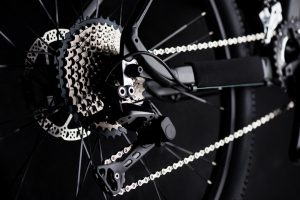
Anyone who wants to ride on tracks and roads that are wetter and colder than usual must first complete this essential step. This is even more important given that cold temperatures may result in less effective braking performance.
For this reason, it is always advisable to inspect it and the shifter before you ride your bike.
Give them a thorough prepping, and inspect the cables for any evidence of accumulating moisture or freezing. Additionally, you might need to install new, improved brake pads.
Examine the brake levers as well. When it’s already wet, can you still manage to keep a firm hold of it? If your hands have a tendency to slip, you must apply some sandpaper-coated tape to assist you to retain a firm grip and avoid any kind of slipping. Additionally, with the right use of pogies or bar mitts, motorcyclists may keep their hands warm while donning smaller gloves, improving their dexterity when using the shifter, brake, and button controls. In temperatures below -20oC (-4oF), heated jackets and gloves can significantly improve comfort. Furthermore, a dropper seat post makes it easier to quickly adjust the seat while riding when the terrain abruptly changes. But we will see these in more detail in dressing and layering tips.
-
Fit the right designed tires and make sure to apply the right pressure

Here, winter tires must be highlighted. Some customers choose tires that can only be used in the rain. They’ll quickly learn, though, that snow is a very different creature, one that will render their tires unusable. Avoid making the same error.
Electric bikes with winter tires can withstand the effects of the cold. This enables them to prevent any typical problems caused by the rubber of the tire stiffening as a direct result of it.
In light of this, be ready to spend some money on these specialty tires. Nevertheless, given their indisputable advantages, they are definitely worth the cost. Many situations call for rimmed, durable winter tires that can tolerate punctures.
However, if you also frequently ride through deep snow, you might want to get studded models as well. These tire types can quite easily plow through that snow and ice. Almost anywhere where the temperature falls below freezing should be traversed as much as possible with studded tires. They may reduce the speed and range of your e-bike, therefore they are not without drawbacks. Always keep this in mind when estimating how much time you will spend riding.
You’ll need studded tires to ride on hard-packed snow, ploughed roads, or ice surfaces.
Use fat tires if you wish to ride on softer snow. E-Lux Electric Bikes has a list of models that accommodate fat tires. While some riders may choose to add zip ties to their tires at certain intervals to increase tire traction, studded tires are definitely the best option for making sure your bike can manage snow and ice.
-
Protect the battery pack and charge it at room temperature
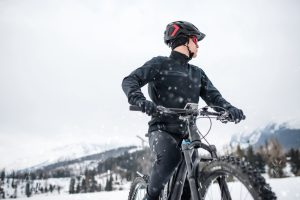
Your e-bike battery is likely to lose power in the cold, as is the case with most batteries.
This can reduce the length of your ride by 10% to 15%. It’s a good idea to bring your battery inside once you’re done riding. It must be warmer than freezing in order for the battery to charge ideally 18-20 centigrade is fine. Keeping it inside can prolong the battery’s life and ensure that it is prepared for charging.
Like some other battery-powered products, electric bike batteries are quite sensitive to temperature changes. The battery’s range will significantly decrease on chilly days. Performance can be subpar. It might seem logical to assume that the more expensive the bike, the better the battery will function under all circumstances, but that isn’t necessarily true. On a blustery ride around the neighborhood, we tested several pricier e-bikes that only lasted a little over an hour.
It’s a good idea to try out the battery life and performance in cold conditions, especially if the goal is to use an e-bike to travel to work during the winter. And in that event, there are a number of additional actions to do to guarantee continuing performance. Consider purchasing a snuggly,to keep your battery warm and safe over the winter. Be ready to recharge your battery far more frequently than you would in the summer. Charge it indoors rather than outside.
Keeping your bike’s battery fully charged is always a good idea. This is particularly crucial during the winter. Your e-battery bike is already a crucial and delicate component, but low temperatures cause it to lose capacity more quickly. Verify that it is fully charged, and always assume that you will get less mileage than on warmer days. Waterproofing your battery case is also an excellent idea. Avoid letting melting snow leak into your battery. This implies that the battery must only be reinserted after everything has dried out. This is a terrific technique to expand the capacity of your battery and could also aid with insulation against the chilly wind.
Some bikers advise removing your batteries when you get back.
-
Clothes and Layering

Now that you are aware of the essential personal protective equipment to purchase, let’s check the safety of your electric bike as well. It’s crucial to protect oneself during a cold ride with warm clothing and safety equipment. The body’s extremities—the head, fingers, and toes—will become chilly first.
-
Hands

The last thing you want while the chilly wind is rubbing across your hands are blisters.
If they are not shielded from the wind, thin mittens will not hold up against the biting cold.
To keep your hands toasty, make sure you have a good pair of snow gloves. Your hands won’t freeze up if you wear thick gloves or mittens, allowing you to control the steering wheel, change gears, and use the brakes with ease. The extremities that will suffer the most, the fingertips, can also receive heat with some of the cool ones online.
The wind and cold can be effectively blocked from freezing your hands with the use of handguards. Although handguards are often only seen on motorcycles, you can consider making them for your electric bike.
Two clever methods for creating your own DIY handguards:
- To stop the wind, cut off plastic bottles and attach them to the handles.
- removing the lower portion of the snow-skiing pants so that it can be attached to the handles
-
Face

Always wear a helmet over your head, and if necessary, a wool cap or headband. Some advice putting on a balaclava below the helmet to protect your face and ears. Your face will suffer from the wind if you are not protected.
Keep in mind that helmets have expiration dates and aren’t indestructible. Purchase a beanie to wear underneath a helmet that fits. Make sure it is secure and does not obstruct your eyesight in any way. Your entire will remain warmer as a result, not just your head. Think about donning ski goggles or anti-glare sunglasses. Wearing these particular glasses dramatically improves your vision. Not to mention that they prevent snow and other debris from obstructing your vision.
You won’t have to deal with the brightness the sun produces because they are also anti-glare, of course. But make sure they won’t fog up quickly.
Additionally, a mask will help keep your face warm throughout the entire ride. Balaclavas with masks are appreciated because of how seamlessly they can provide enough heat while also facilitating easy and comfortable breathing. If you have the right safety clothing for it, you might want to extend the warmth to your neck as well.
-
Reflectors and warm clothing
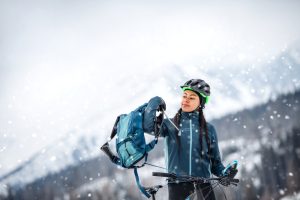
It’s crucial to dress warmly and wear a windproof jacket, but reflectors on the outer jacket are also a good idea.
Remember that the days are getting shorter and darker because it is winter.
Maintain your safety and assist the other drivers! On the darker days, they must be able to see you well when you are driving.
-
Shoes and Socks
Wool socks for your toes will keep them warm and dry. The last thing you want is cold, damp toes, similar to when you’re trekking. Discover the perfect socks that are not too thick, yet still, keep you warm and wick moisture away.
Having said that, look for waterproof footwear. Your toes will become quite cold even if you are wearing wool socks that wick away your perspiration. Additionally, keep in mind that you will be putting your foot down on different occasions, and if there is snow on the ground, you don’t want it getting inside your shoes.
Hit your preferred e-bike route once your bike has been winterized and you have dressed appropriately. In the winter, many of these routes are probably more deserted, which can make for a tranquil experience. You will be alone with your electric bike and the lovely, sparkling, snow-covered landscape. You can test-ride a bike in a city close to you thanks to our nationwide shipping and dealer network. Don’t let a little snow prevent you from enjoying the outdoors.
Include it in the mix.
-
Layering
When it comes to choosing your outfit, it is advisable to concentrate on layers.
This will make it simple for you to take off clothing when the temperature rises and to put them back on when it drops. Be cautious when choosing the fabric for your clothing.
They should be able to limit moisture buildup and offer the appropriate level of comfort.
Wool is an alternative, but make sure it is of great quality and won’t make you itch in the end.
-
Ride with caution

It can be enjoyable to ride in the snow, but before you go, make sure you are comfortable with your riding skills. In order to get a feel for the terrain, it is best to start your bike without the motor. For visibility, equip your bike with LED lights. Always follow the rules of the road you’re traveling on. Riding in the winter simply presents a variety of unique dangers that are not often present in the summer. These dangers include slippery surfaces, unpredictably bad weather, and motorists who might not expect to see bicycles in bike lanes.
Planning and readiness are beneficial when cycling in the winter. If you find yourself in unanticipated weather, make sure you have the clothes you need to be warm. Lights are a good idea for the shorter days, and fenders are a good idea if you can. The most crucial thing, though, is probably to simply pay attention to the things that are in your immediate path. Just a little bit slower speeding up before corners and keeping an eye out for the sheen of black ice.
-
Riding technique
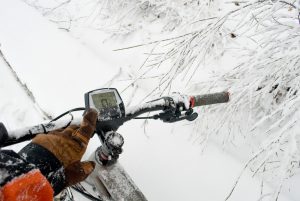
It’s important to keep in mind that riding on snow or ice requires you to adjust your normal e-bike behavior. However, most of this is simply common sense and doesn’t call for advanced riding skills that are beyond the range of most e-bikes.
Steering, braking, and pedaling should be done more slowly. Quick starts and stops, abrupt motions, and greater force on your tire contact patch all enhance the likelihood of skidding.
This is especially true if you don’t ride an electric mountain bike, electric fat bike, or have studded tires. If your e-bike has a throttle control feature, use it slowly and carefully.
It’s evident that applying light pedal pressure at a single speed is not practical, thus a good range of gears will be helpful in this regard.
Additionally, The Seat Can Be Lowered to Help. Before going for a ride in the winter, you might want to consider lowering your site. This will reduce your center of gravity and provide you the opportunity to rapidly plant your feet if you start to lose control. This can really help if you’re concerned about safety.
While gliding along on your electric bike in the snow, don’t attempt to break any speed records.
Even if you become accustomed to pedaling in the snow and ice, you shouldn’t take the chance of colliding with something. If you move more quickly, falling will hurt more severely.
Keep it under control and move slowly.
So still you have doubts like, “Can I ride an e-bike safely during the winter?” Yes, if you keep in mind all of our recommendations and make it a point to follow them during the winter. Any sensible rider who wants to maintain road safety and extend the life of his e-bike while riding in the winter should expect nothing less. Maintaining a careful balance when outfitting both you and your e-bike with winter-specific gear and gadgets is important. Recalling them would not be harmful either.
